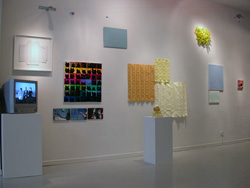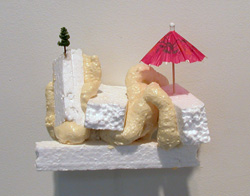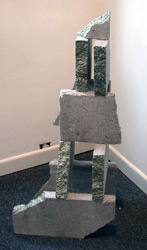
|
||
|
Portland art blog + news + exhibition reviews + galleries + contemporary northwest art
|
||
Treasure Hunting at Bay Area Bazaar
Walking into the salon-style exhibition of Bay area artists at Pulliam Deffenbaugh, I thought perhaps The Affair had landed one month too early, on the wrong side of the river. For their last show on 12th Avenue before unveiling an impressive space on what is developing as the Pearl District's new hotspot, Pulliam Deffenbaugh invited artist Laurie Reid to curate a show of over 50 Bay Area artists. Reid, known for airy, delicate watercolors, selected work based on her own network of friends, colleagues and influences in the Bay Area. Since the show lacks an underlying concept, the work is all over the map, many very likable, some rather unremarkable. While it didn't provide more than a somewhat haphazard survey of San Francisco's art scene, there were plenty of rewards to be found among the overwhelming volume of work on display. Charles Beronio's Color Extraction (after Betsy Ross), an American flag pieced together by all-white fabric, is at once a formal study, a reflection on the political weightiness of this symbol and a jab at appropriation art, citing the seamstress that sewed the first flag and ignoring more expected precedents like Jasper Johns' White Flag. I was dismayed to learn later that Seattle artist Jack Daws had created a nearly identical piece in 2001, since Beronio created a rich contextualization for the piece, bringing much more to the table than just an obvious set of political overtones.
There was plenty of proof that the kinds of small, often clumsily executed crafty work that Jerry Saltz once deemed "termite art" is alive and well, including Dustin Fosnot's diminutive landscape created with cliffs of styrofoam graced by a pink cocktail umbrella. Other such work included ariel sculptures that looked like satellites and moved along a thin rope strung across one end of the gallery; a two inch high striped lawn chair; a small felt hill by Emily Sevier that reminded me of Amanda Wojik's fantastical terrains (though much less sophisticated); and a small assemblage held together with bungee cords and embellished with garish pink feathers.
Mitzi Pederson's glitter-edged cinderblock constructions come out of this same vein of work, but whereas most of the other work simply revels in its own triteness, Pederson's sculpture slyly infers other possibilities. Cinderblocks, whose corners are broken to reveal an improbably glittery interior, are stacked on top of each other. The juxtaposition of two unlikely materials result in an intriguing formal resonance between the porous grey surface of the utilitarian cinderblocks with the frivolousness of silver glitter. The architectural qualities of the constructions also recall drab 1960s era social housing, glitter evoking a world of utopian promise. Scott Oliver also uses commonplace materials, but his labor intensive Always Daylight No 1, a lighted wall piece whose structure is formed out of its elaborately braided power cable, takes a cue from the tradition of craftsmanship rather than the intentionally shabby craftiness of "termite art." Among the handful of more well-known names included in the show is work by Kota Ezawa, whose Chelsea debut is currently on view at Murray Guy. In the back room of Pulliam Deffenbaugh is Ezawa's work in progress, The History of Photography Remix, a slideshow documenting some of the most recognizable images taken not only from the history of photography but also from photographic documentation of conceptual art. Using his signature style - severe abstractions that fall somewhere between the vectorized portraits prevalent in graphic design right now and the crude style of South Park - Ezawa departs from the animations of earlier work like The Simpson Verdict, reinterpreting the history of photography as a slideshow. Although Ezawa generates these images on a computer, he chooses to generate the images freehand rather than by retracing the original media sources, resulting in a strange tension between the hand drawn and the digitally generated. In The History of Photography, imagery is borrowed from the expected cast of influential photographers (Ansel Adams, Nan Goldin, Bern and Hilla Becher) as well as more unlikely sources (Yves Klein's Leap Into the Void, photo documentation of Gordon Matta-Clark's Office Baroque). All seem to be cropped or redrawn as if the photo were taken from a different angle, an imagining of the real time circumstances that lie behind each photograph. Through October 1 Posted by Katherine Bovee on September 18, 2005 at 23:15 | Comments (0) Comments Post a comment Thanks for signing in, . Now you can comment. (sign out)
(If you haven't left a comment here before, you may need to be approved by
the site owner before your comment will appear. Until then, it won't appear
on the entry. Thanks for waiting.)
|
| s p o n s o r s |
 |
 |
 |
 |
 |
 |
 |
 |
 |
 |
 |
 |
 |
 |

|
Site Design: Jennifer Armbrust | • | Site Development: Philippe Blanc & Katherine Bovee | |




